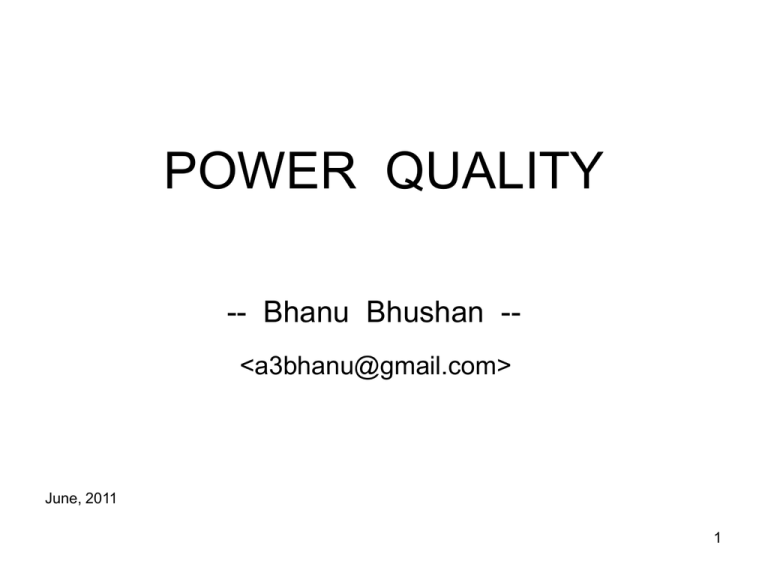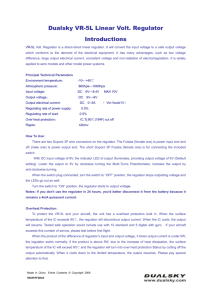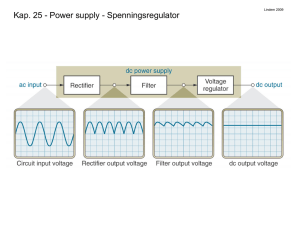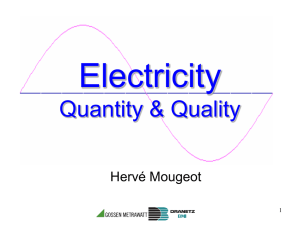POWER QUALITY -- An Indian Perspective
advertisement

POWER QUALITY -- Bhanu Bhushan -<a3bhanu@gmail.com> June, 2011 1 • How close is the supply voltage waveform to sinusoidal, and how close are the supply voltage and frequency to the rated ? • What Power Quality do we actually have ? What Power Quality do we really need ? 2 POWER QUALITY in a wider, Indian perspective GRID - Level & CONSUMER - Level 1) SUPPLY CONTINUITY 2) FREQUENCY 3) VOLTAGE 3 SUPPLY INTERRUPTIONS a) LOAD - SHEDDING due to own or others’ over-drawal : Maximize generation, and allow over-drawal, as long as grid can sustain it, and it is paid for. b) LOAD - SHEDDING to curtail over-loading or under-voltage : If too frequent, ask for system augmentation, additional capacitors. 4 c) TRIPPING due to a fault or equipment failure : Minimize outage duration, : Reliable protection, Auto-reclosing, : Ask for building redundancies. FREQUENCY : covered in another session. 5 VOLTAGE PROBLEMS • HIGH / LOW : Can be corrected by transformer tap-changing and reactive compensation : shunt / series capacitors, reactors, SVC, MVAR generation change. • SWELLS & SAGS, SPIKES & DIPS, FLICKER : Caused by switching on / off of large loads, capacitor banks, electric furnaces, welding machines. 6 • PHASE UNBALANCE : Caused by single - phase or unbalanced loads (e.g. railway traction), pole - discrepancy, break in a phase (conductor snapping), break in neutral, hanging faults, non-transposition. • WAVE FORM DISTORTIONS (HARMONICS and DC offset) : caused by HVDC, SVC, FACTS, Converters, UPS, power / speed controllers, computers, TVs, chargers, printers, tube-lights, CFLs, fan regulators, electronic ballasts, 7 communication equipment, arc furnaces, welding, railway traction, etc. Circuit breaker and isolator operation (switching transients), L.A., transformer magnetizing current inrush, lightning, Faults and their clearance, insulator flashover, corona, faulty grounding. Adverse effects : Over-heating & noise, resonance, telephone interference, hum, capacitor failure, mal-operation of control device and medical equipment. 8 POSSIBLE SOLUTIONS : Circuit segregation, harmonic filters, U.P.S. DAMPING by synchronous and induction machines. A use of harmonics: Harmonic restraint in transformer differential relays. 9 10 11 12 13 Simple examples around us : • Ceiling fan regulators • Tube lights • Lap-tops & peripherals • Domestic inverters 14 Ceiling fans -- 1- ph Induction motors, shaded - pole or split - winding, inverted. Fan regulators -- 3 different types: i) Choke : weighty, costly, low PF ii) Resistor : energy loss, heating iii) Electronic : voltage and current distortions, harmful on both sides. 15 Supply voltage and fan current, regulated by old resistance type regulator, at full-speed 16 Supply voltage and fan current, regulated by old resistance type regulator, at low speed 17 Fan current, regulated by electronic regulator, at full speed 18 Fan current, regulated by electronic regulator, at low speed 19 Harmonics in fan current, at low speed, with electronic regulator 20 Voltage wave form, after electronic regulator 21 Harmonics in fan voltage, at low speed 22 Tube lights : non-linear discharge lamps. Smoothening & PF improvement by choke and capacitor. Not a serious problem. Electronic ballasts : V & I distortions ? 23 Tube light current waveform 24 Lap-tops & peripherals : AC / DC adapters draw non-sinusoidal current. Domestic inverters : Battery charging current is always non-sinusoidal. INDUSTRIAL U.P.S. 25 Voltage Wave form – UPS output 26 Harmonics in UPS output voltage 27 IEEE Standard 519 - 1992 Recommended Practices and Requirements for Harmonic Control in Electrical Power Systems 28











